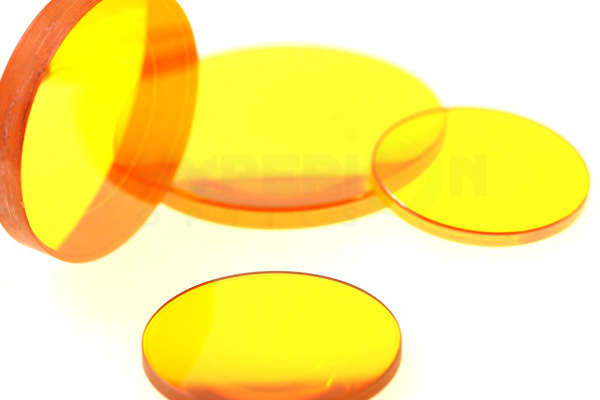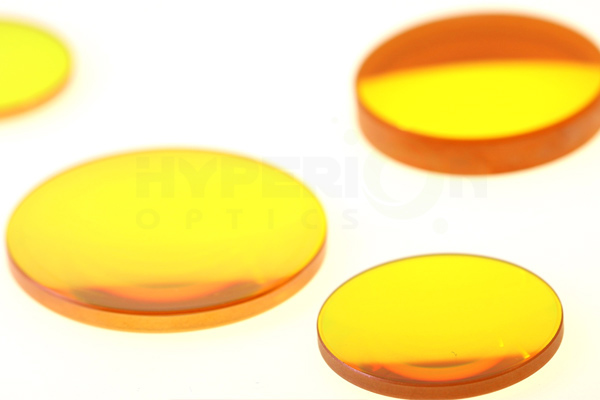Protect scan lenses from backsplatter and other workplace hazards, Hyperion Optics offers protective windows -- also known as debris windows -- that are either included as the overall scan lens assembly part, or sold separately. These plano-plano windows are available in both ZnSe and Ge materials and also supplied mounted or unmounted.
ZnSe protective windows feature our standard AR or DAR coating. Ge protective windows feature either our standard AR coating, or an optional diamond-like carbon coating (DLC) designed to withstand the most severe conditions likely to be encountered in industrial operations.
For lasers with infrared wavelengths, such as, for example, 10.6 µm in CO2 lasers, lenses and windows made of zinc selenide (ZnSe) are used. Silicon or copper mirrors are used as mirrors. Phase shift mirrors used to produce circular polarization are also available. Beam expanders and diffractive elements for beam shapes complete our product range.
Zinc selenide components are primarily used for transmissive optics. They are made exclusively with high quality "laser grade" material that can be used even in the kW range. When coated, these zinc selenide elements have a transmittance of T > 99.5 % at 10.6 µm


The laser is the interaction between light and matter, which is essentially the microscopic particles that make up the material to absorb or radiate the photon, and change the performance of the motion of itself.
Lasers have many properties: First, lasers are monochrome, or single-frequency. There are lasers that can produce different frequencies at the same time, but these lasers are isolated and used separately. Second, lasers are coherent light. The characteristic of coherent light is that all its light waves are synchronized, and the whole beam is like a "wave train". Thrid, the laser is highly concentrated, which means it can go a long way before dispersed or restrained.
Laser is a new light source which has been applied in many fields.With the rapid development and wide application of laser technology, laser has become an important tool in industrial production, scientific exploration and modern military warfare. Laser has good control of space and time, it has a lot of freedom for the material, shape, size and processing environment of the objects. It especially suitable for automated processing. The combination of laser processing system and computer numerical control technology constitutes efficient automated processing equipment, opening up a broad prospect for high quality, high efficiency and low cost production.
Laser optical components include laser crystal, optical lens, optical filter, optical lens, window glass, prism, beam splitter, beam expander and so on. It is widely used in microscopes, imaging and fields like interferometry, industry, life sciences, testing and measurement.
Laser glass is the application of laser, it is a kind of solid laser material with glass base. It is widely used in all kinds of solid laser optical device and is the main laser material of high power and high energy laser device.
Laser reflector is a high quality reflector used in laser resonator and other optical devices.
In general, the laser reflector is prepared on the glass substrate, but it can also be coated directly on the crystal of the laser. For example, a monolithic laser. Usually the reflector substrate is elliptical shape, even for high reflectors, the properties of the substrate are very important, especially the surface quality and high rigidity, low thermal expansion coefficient, high thermal conductivity (avoiding thermal expansion in high power laser). For some transmission reflectors, it also requires high optical uniformity (avoiding the optical aberration of transmitted light), low absorption and scattering loss.
The reflector substrate may have curved surface leading to the focus or defocus of the laser reflector. In the case of normal incidence, the effective focal length is half of the radius of curvature.
 Call us on:
Call us on:  Email us:
Email us:  R&D Center: 9B-4F 401,No.1 Qingnian Road Liando U Valley,Yuhua International Wisdom Valley, Nanjing, 210039 China
R&D Center: 9B-4F 401,No.1 Qingnian Road Liando U Valley,Yuhua International Wisdom Valley, Nanjing, 210039 China









 English
English  cn
cn  de
de  es
es  fr
fr 


